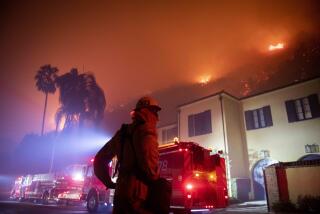HomeFed Joins Slide in Prices of S&L; Stock : Bailout: Investors’ enthusiasm appears to be dimming, even for the higher-quality savings and loans.
- Share via
Until recently a bright light in the otherwise gloomy savings-and-loan firmament, HomeFed Corp. stock has dropped more than $12.50, or 25%, over the last three weeks to close Monday at $35, a sign of investors’ dimming enthusiasm for even higher-quality S&Ls.;
The drop was precipitated by a decrease in HomeFed’s third-quarter earnings resulting mainly from higher loan loss provisions set aside to deal with an alarming jump in non-performing loans. The non-performers as of Sept. 30 were 2.85% of assets, up from 2.45% of assets as of June 30. HomeFed’s apartment loans are particularly problematic, analysts said.
HomeFed’s provisions to cover probable loans losses were $22.9 million for the quarter, more than double the $10 million for the second quarter this year. The provisions caused HomeFed third-quarter profit to slip to $23.9 million from $27.9 million for the year-ago period.
Not exactly apocalyptic news, but nevertheless damaging for HomeFed, which seemed immune to the severe loan quality problems experienced by other San Diego-based S&Ls; of late. On Oct. 23 before the earnings were announced, HomeFed stock was selling as high as $42.50.
HomeFed President Robert Adelizzi on Monday downplayed the stock drop, saying the shares experienced a run-up earlier this year fueled by ungrounded takeover speculation. He placed the stock drop, as well as that of other S&L; stocks, within the context of an industry victimized by increased economic uncertainty, the volatility of the stock market in general, and the after-effects of the S&L; bailout bill that could lead to a glut of foreclosed real estate put on the market by federal regulators.
On top of that, California S&L; stocks have been affected by the earthquake and fears that some borrowers will walk away from mortgaged properties, Adelizzi said.
Although he acknowledged that the size of the loan loss provision was something of a surprise, Adelizzi said the S&L;’s problems with apartment loans have been hinted at in public disclosures over three years, ever since changes in the tax law in 1986 made apartments a less desirable investment.
Nancy G. Spady, a savings-and-loan analyst with Morgan Stanley investment bankers in New York said that Home Fed stock’s decline illustrates how investors are “very scared about credit quality. HomeFed doesn’t look that bad, but investors are worked up about the non-performing loan portfolio.”
Shares of two other locally based S&Ls;, Great American Bank and Imperial Corp. of America, parent of Imperial Savings of California, have also been battered in recent days. Both S&Ls;’ stocks hit new lows last week after each reported huge losses caused by provisions set aside to cover expected loan and investment losses.
Great American, whose shares closed off $.50 at $8.375 Monday, down from a 52-week high of $14.875, has been beset by problems with its $800-million Arizona commercial real estate loan portfolio, problems that analysts fear are far from over. Two weeks ago, Great American set aside reserves totaling $93 million to cover bad real estate loans, more than half of them in Arizona. The provisions resulted in a third quarter loss of $59.4 million.
The deteriorating portfolio prompted Standard & Poor’s credit rating service to downgrade Great American’s bonds last week. And, despite the stock’s decline, Standard & Poor’s Outlook investment newsletter last week put out a “sell” recommendation on Great American.
Great American’s market valuation, figured by multiplying the stock price times fully diluted shares outstanding, is down to about $200 million. As one local investment counselor pointed out, Great American, with its 214 branches, is worth less than double the $112 million that Security Pacific National Bank could end up paying for 12-branch La Jolla Bank & Trust, if an agreement signed by the banks last week is consummated.
“Great American says its bad loans are adequately reserved for, according to current values, and I believe them,” said the investment counselor, who asked not to be identified. “But what happens if the Arizona market continues to deteriorate as it did in Texas? The answer is, we just don’t know.”
Spady of Morgan Stanley said the true value of the Arizona loan portfolio is “unknowable. I just don’t know what the bottom is and whether we’re there yet.”
ICA stock closed at $1.75 per share Monday. The S&L; last week reported a $103.1-million third-quarter loss, thanks in large part to a $92.2-million after-tax loss on its $1.2-billion junk bond portfolio. The provisions of the federal S&L; rescue bill passed last summer forced ICA to write down the value of its junk bonds to current market value.
ICA Executive Vice President Kevin Villani said all S&L; stocks are being adversely affected by the S&L; rescue bill because it is still unclear “what will be left for shareholders as you go through shrinkage and recapitalization scenarios” required of many S&Ls; by the bill’s stiffer capital requirements.
ICA, for example, is shrinking assets by $2 billion to meet regulators’ terms. “You are in a very uncertain world,” Villani said of ICA.
More to Read
Inside the business of entertainment
The Wide Shot brings you news, analysis and insights on everything from streaming wars to production — and what it all means for the future.
You may occasionally receive promotional content from the Los Angeles Times.










